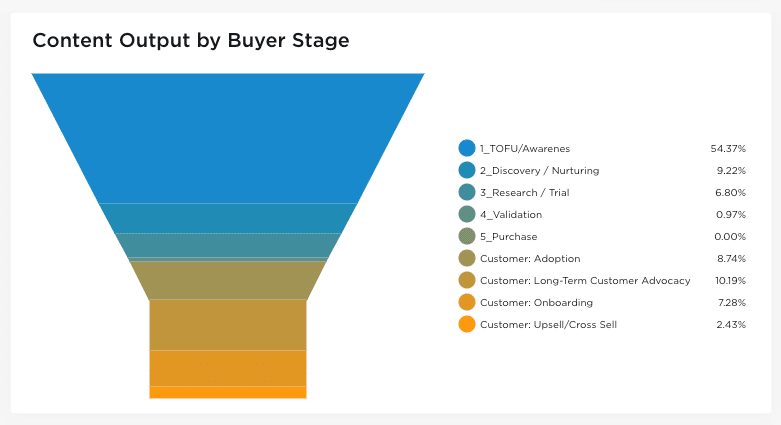Does content planning bring about anxiety and dread? It can often be one of the most daunting aspects of the content marketing process. It’s an exercise that requires structure, brainpower, time and effort, but without a solid content plan, it’s almost impossible to be successful in your content efforts.
So, perhaps it’s time we remove some of that trepidation. Let’s simplify with eight content planning hacks to streamline your process.
But before we dig in, let’s first make sure we’re on the same page as far as the basics. What exactly is content planning? What does the process entail? Hint: it’s different than your content strategy!
What Is Content Planning?
Content planning includes all the preparatory activities you must undertake to execute your content strategy. It’s the action plan that identifies the what, when, where and how. And, it can be a real challenge for many content teams to flush all that out in proper detail.
There are six key elements to content planning:
- Gathering, plotting and scheming: considering both audience needs and business objectives, content ideas need to be conceived and approved for execution
- Scheduling with a content calendar: a visible and centrally located hub for all campaign timelines and asset production deadlines
- Documenting processes and content workflows: alignment across all stakeholders ensures consistency
- Transparency and communication: eliminate barriers to effective content collaboration
- Distribution and promotional plans: publishing details and content to get your content in front of your audience
- Optimizing and measurement: tracking metrics to discern if strategic objectives are being met
So how can you best execute content planning? There are many content planning strategies that you can employ to streamline processes. Let’s take a look at eight hacks you might want to incorporate into your process right away.
8 Content Planning Hacks
1. Pick an Actionable Goal
The goal of content marketing is to compel an audience to take action. Thus, you should start your content planning by focusing on what you want your target market to do, not what you want them to know.
To simplify this, narrow your focus down to one specific action. Maybe you’re trying to get prospects to subscribe to your blog, download a gated asset, sign up for a webinar, schedule a demo, or complete a contact form. By starting with the action, your content plan has a definable goal. Then each piece of content you choose for your plan will be connected to that measurable result.
2. What Questions Keep Coming Up?
Your audience is the key to your content topics. You must have intimate knowledge of their pain points and motivations, typically fleshed out in buyer personas. But that’s just the beginning. You need to pay close attention to the questions they ask.
Get your team together and pull in some representatives from sales and customer support. Ask everyone to do a brain dump of every customer question they can think of. With those questions, you can develop content topics that are a response to those most-asked questions.
3. Quick Buyer’s Journey Gap Analysis
A typical buyer’s journey includes at least three stages: awareness, consideration, and decision. At any given time, you’ll have audiences in each of these stages, so there should be experiences or assets developed for each.
In my experience, most companies tend to have a shortage of content within one or more of these stages. For example, a company that relies heavily on organic search traffic to drive traffic and leads may focus heavily on awareness-stage content, but only have a handful of decision-stage assets.
Alternatively, decision-stage content is probably most tied to revenue, so many companies place a heavy focus on that. But when you look at the funnel numbers, the number of buyers in your decision stage will be minimal. So while that content may be impactful for getting prospects past the finish line, the lack of top-of-funnel focus may mean a much smaller pipeline.
When planning, it’s helpful to have some mechanism for tracking and reporting to identify gaps like these, and ensure that you have enough content that aligns with each phase of the buyer journey. If not, then get to work filling those gaps!
Screenshot from DivvyHQ Analytics
4. Leverage Internal Subject Matter Experts
Want a smoother process for generating ideas your audience will love? Then lean on the expertise of internal SMEs. These folks may not be part of your content team, but they have a wealth of knowledge. Consider ways you can involve them in content planning.
One way is to put on your reporter hat and go talk to them regularly. Assuming these are busy people, ask if you can sit with them over lunch to pick their brain. Most SMEs are passionate about their work, so getting them talking may often result in pages of notes, tidbits and interesting stories.
Another way is to create an idea repository in your content calendar as part of a content marketing platform. With this space, you can invite those outside the content team to provide ideas. Then you can map out those ideas further. It may prove more effective than just sending these SMEs emails or trying to plan time to meet with them.
5. Use Content Prompts to Generate Ideas
At some point, the well of ideas will run dry. You may think there’s no way you can spin another topic. But there are always opportunities to generate new ideas. Using content prompts can be an excellent content planning hack to energize your content team.
Here are a few prompts that can lead to highly consumable content:
- Solve a problem
- Explain a solution, the industry, or process
- Give readers a glimpse at your secrets
- Embrace your brand’s unique identity
- Explore the implications of a trend
- Start with a statistic
- Ask a provocative question
These should get the creative juices flowing and lead to some fresh, fascinating content.
6. Look to Campaign Plan Archives for New Inspiration
Remembering the past is often an effective way to develop for the future. Looking at past campaigns and dissecting individual campaign assets to see what you did and why those assets were effective can help spur new ideas. If you have a campaign archive and content analytics easily accessible, you have a clear picture of what you should do going forward.
7. What’s Working? Let’s Repurpose It
Along similar lines, consider how you could take a piece of content that performed really well and expand upon it for a new post. Or think about how you could repurpose it. For example, if one of your ebooks had a high number of downloads, perhaps you can turn it into an infographic, or webinar, or a short explainer video.
8. Technology = Visibility = Inspiration & Collaboration
While you may not consider “visibility” to be a content planning hack, it is. So many companies are marred in departmental silos and they continually plan and create content within closed bubbles.
By simply implementing a content marketing platform that provides visibility and transparency between siloed teams, all stakeholders and creatives then have a comprehensive view of content themes, topics and tactics that other teams are executing.
When the right hand can see what the left hand is planning, inspiration and collaboration follow.
9. BONUS HACK!
Bring pizza to planning meetings. You’ll get plenty of participation. It works like a charm…;)
Content Planning Deeper Dive
If you’ve made it all the way through this list, we appreciate you. We truly love working with teams who strive to improve their content planning processes. Note though that these are just a few content marketing hacks that could improve your process and make it less daunting.
If you’d like more guidance on the ins and outs of content planning, you should definitely check out our recent ebook, “The Definitive Guide to Planning a New Content Initiative.” It’s a beefy guide that is perfect for kicking off your next content initiative the right way. Get your copy today.

